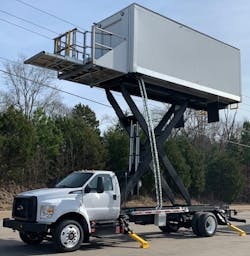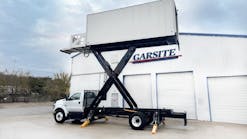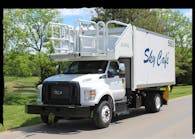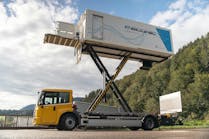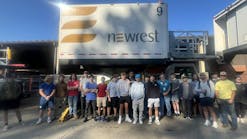While cruising at 30,000 feet, an airline passenger enjoying his or her meal likely doesn’t give much thought to how their food got from the ground to their tray table. For airlines and ground crews getting that food to the plane, the crucial part of that equation is the catering truck. However, what goes into picking a catering truck and what a purchasing manager should look for when spec’ing trucks is not as straightforward. There are, though, a few tips, tricks and things to keep in mind before making a decision.
GSE manufacturers DOLL, Timsan and Smith Transportation Equipment each produce catering trucks and offer different buying options and advice to consider when shopping for your next catering truck.
DOLL
DOLL’s line of catering trucks includes three different sizes of trucks, called X-CATS. X stands for the hydraulic scissors and CAT is for CATering, says Katharina Luchner, head of marketing at DOLL. There is the X-CAT L, X-CAT M and X-CAT S.
“The main difference between all of our products is the sill height. With our range of high-loader, we can operate a CRJ 1000 but also an Airbus A380 on both decks,” says Luchner. “Starting from a length of 6,900 mm for the S version, the L version is around 11,000 mm. The sill height starts at 1,000 mm up to 8,000 mm.”
All of DOLL’s trucks are in ATP accordance, allowing them to transport perishable foodstuffs on not only the airport apron, but also on the road.
“Our bodies are made of insulated fiberboard. Synthetic materials and polymers define the sandwich structure of our boxes. A high-density foam completes this insulation. You just have to imagine our structure as a kind of giant fridge. This allows us to preserve food in the best possible conditions,” elaborates Luchner.
The lift can be controlled from either inside the cab or the body of the catering truck. The functions inside the cab are limited, Luchner notes. Mainly, operators inside the cab are able to position the truck to the optimal spot to use the scissor lift.
“Inside the body are all the functions available. You can put the body up and down, get out the platform, etc. All this, in complete safety with a lot of sensors which prevent any handling error,” Luchner says.
While the purchasing decision can be a complicated process, Luchner suggests focusing on specific details.
“The main element of the choice is definitively the planes to be operated. It will define the size of the needed truck (S, M, L). The quantity of trucks to be purchased will depend on the number of meals to be delivered per day and the number of flights to be operated,” says Luchner. “Climate has little influence on the choice of catering truck, but one thing is certain: trucks must be resistant to bad weather, and therefore to rust. DOLL benefits for this to the highest corrosion prevention due to high-quality coating with galvanizing and powder coating.”
And DOLL offers several options for their trucks, as well, including a reverse camera, additional working light and the company’s latest safety feature, the DOLL SAS Safety Approach System.
“It is a camera system that detects an aircraft, evaluates the distance between it and the aircraft and automatically brakes the truck at 0.5 m from the aircraft. This allows us to be in perfect compliance with the IATA AHM913 ‘no-touch policy’ standard. Almost all options are possible, and we are sometimes acting like a ‘tailor-made’ truck provider,” says Luchner.
Timsan
At Timsan, Uluğ Kaya, mechanical engineer and design center manager, says all their catering trucks are made to their customer’s requirements and specifications.
“We divide our products into two, as lower deck and upper deck catering trucks and are named according to the max service height. But at Timsan, we do our best to meet our customer's requirements with tailor-made understanding,” Kaya describes.
The custom nature of Timsan’s trucks leads Kaya to offer the following advice for purchasing.
“When purchasing a catering truck, firstly, the aircraft types have the most effective role to configure the type and capacity of the unit. Secondly, trolley capacity, which is also determined by the aircraft and airport size, also has a key role. These two features are also used to determine the truck brand and capacity. After these two main features, environmental condition is also important to verify the insulation and cooling unit. And finally, the tail lift necessity is important according to customer facility. If these four features are agreed, the rest of the features like four-way-platform, half cab four-way-platform, pneumatic sliding doors, side door, stainless steel shelves, pneumatic controlled trolley fixing mechanism, different types of cooling unit, tail lift, canopy for platform, access bridge, electric emergency pump, Can-Open PLC system, proportional hydraulic system, some safety features like cameras, anti-collision sensors are all optional features we can provide for our customers,” says Kaya.
For aircraft height, Timsan manufactures their trucks to meet several ranges.
“The aircraft sill heights vary from 1 m to 8.4 m. This range is said to be too long for a catering vehicle mounted on a commercial truck. If an A380 is considered, a specially designed catering truck is required. These reasons force us to design several types of catering trucks that exactly meet this range. From 1.3 m to 6 m a half cab catering truck, from 2.5 m to 6 m full cab catering truck, and only for the A380, a specially designed catering truck must be used,” Kaya says.
When considering climate, Kaya says: “In some places like the environment temperature is around desired values for keeping the food/drinks cool during most of the year, only an insulated van body is enough. But in places where the temperature is around 20-25 degrees C or above most of the year, in this case a cooling unit must be used with an insulated van body to keep food/drinks cool. The thickness of the panels varies according to the environmental conditions and operational requirement and customer demand as well.
“When working directly with people and in the aviation sector, one of the most important things we focus on is safety,” adds Kaya. “Both safety for people and the process itself. Beside the safety in construction and stabilization, there are many features on the catering truck for safe operations such as lock valves, emergency push buttons and inter-lock system. Since the beginning of 2019, according to AHM913, Aircraft Safe Approaching System has started to be implemented in our catering trucks, as well as our related products, which control the truck speed and distance to aircraft to meet ‘no-touch policy.’”
Smith Transportation Equipment
While they offer three different models of catering trucks, Logan Smith, director of sales and marketing for Smith Transportation Equipment, says that they offer multiple variations within those models.
“The three basic types are: MH10x12, regional jet; MH16x16, narrow body; and MH18x21, wide body. The biggest distinctions between the models are the servicing heights and lifting capacities,” says Smith. “Ultimately, the van body height and width are pretty consistent. The variance is in the overall length. We offer 11’, 12’, 14’, 16’, 18’, 21’, 22’ and 24’ boxes.”
Smith agrees that, when choosing a catering truck, taking into account the size of the aircraft being served is paramount. But he says that there’s more that goes into shopping for trucks than just that.
“Spec’ing a catering truck is akin to selecting a manufacturer. We are a prime manufacturer, meaning we manufacture all of our major assemblies, such as the scissor mechanism, stabilizers, van body, forward platform, etc. Such capabilities enable the conformity to the customers’ requirements and meet delivery timetables while monitoring the strictest quality standards. Meeting customer’s specifications, quality assurances and defined completion dates build a solid program with our customers,” Smith says.
Some of Smith Transportation Equipment’s customers do not have detailed specifications for their trucks, Smith adds, and thus rely on the company to help them develop standards for their needs.
For lift capabilities, Smith says their regional jet catering trucks range from 1,500 to 3,000 lbs., narrow body trucks can lift 8,000 lbs. and their wide body trucks have a lift capacity of 10,000 lbs.
“Spec’ing an increased lifting capacity is certainly possible but could give customers a higher rated chassis than they’re accustomed to and potentially present issues with driver certifications,” Smith continues.
To keep the perishables fresh, Smith says they’ve found that the optimal insulation package is polyisocyanurate foamed sidewalls and urethane foamed roof/floors.
Regarding climate, Smith says trucks are rated to work at extreme ranges in regards to temperature.
“If the conditions are extreme, we recommend refrigeration with defrost, fuel and hydraulic tank heaters, battery warmers, engine block heaters and artic fluids,” he says.
Smith suggests customers also keep in mind truck safety. First and foremost, a truck must meet the wind stability and structural safety requirements outlined by ANSI and SAE International, he says.
“We utilize several interlocks to ensure safe and proper catering operations. Additional safety features include: all cylinders are equipped with a hydraulic lock valve, engine kill button, audible and visual indicators for rear door ajar, reverse circuits, 360-degree camera system, ultrasonic sensor system, etc.,” continues Smith. “Since 1996, we have attended/hosted numerous Under the Wing safety meetings and international standard reviews. Over the last 2,000 units manufactured, we are constantly updating our standards to include the most up-to-date techniques and products to alleviate personal injuries, damage to aircraft and vehicle damage.”
